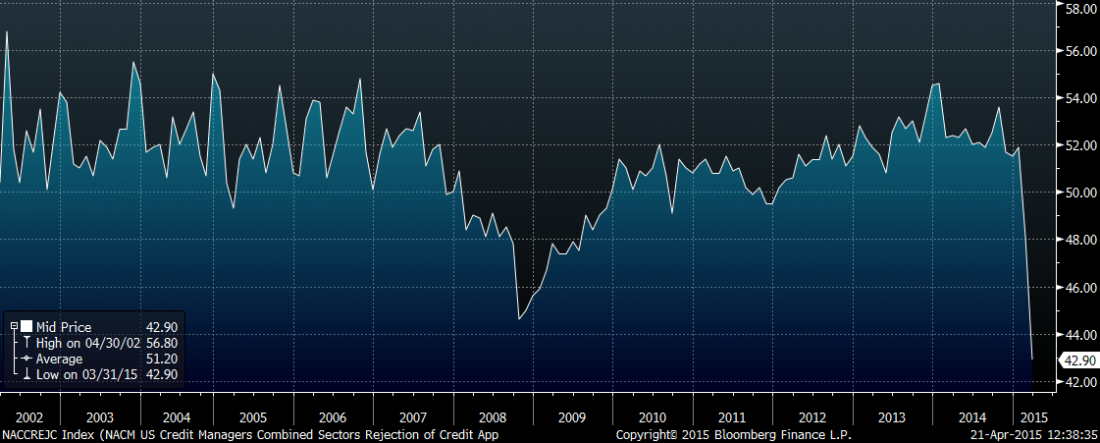The question about a credit crunch is an important one. Here are three data points to consider regarding this issue.
First, the Chicago Federal Reserve National Activity Index (CFNAI) report was released Monday at -0.42. This is about as low as it has ever printed (it’s been lower only nine months out of the past five years). The three month smoothed moving average is -0.27, which hasn’t been that negative since the end of 2010.
Second, the Atlanta Federal Reserve GDP Now model forecast for Q1 GDP, which was as high as 2.3% in early February and has crashed to 0.1% as of April 16.
Third is the National Association of Credit Management Report, which I had never seen until the last time it was released at the end of March. The chart of Credit Application Rejections is shown below. I haven’t seen rejection like that since Marie Trofimuk shut me down when I asked her to the high school dance. From the report: “The real damage is showing up in the unfavorable categories. By far the most disturbing is the rejection of credit applications, as this has fallen from an already weak 48.1 to 42.9. This is credit crunch territory not seen since the very start of the 2007 recession. Suddenly companies are having a very hard time getting credit.”

Think about this report in conjunction with Jeffrey Immelt’s announcement that GE is winding down GE Capital. “GE Capital has solid businesses and a great team,” Immelt said. “However, the business model for large, wholesale-funded financial companies has changed, making it increasingly difficult to generate acceptable returns going forward.” GE wants to rid itself of the “systemically important financial institution” designation. GE had used its strong balance sheet and relatively cheap borrowing costs in the corporate bond market to finance other companies at a healthy spread. The decision to unwind this business underscores the idea of tightening credit availability.
Stanley Druckenmiller has warned about record corporate debt levels, and the increase of “covenant lite” debt structures. From my perspective, it looks as though the credit spigot, which has been on full blast, is being turned down; the smart guys are deciding that the risk/reward ratio just isn’t up to snuff. There was a Reuters piece the other day that noted”… companies are tapping more of their credit lines to fund hiring and expand their businesses, a promising sign for the economy.”
This article goes on to mention increased confidence of businesses, but I wonder if it isn’t more a sign of desperation. Does this explanation square with the Credit Management Report referenced above? That we are in “credit crunch territory”?
The Fed has run out of rope in its efforts to spur the economy in case of a slowdown.
Fed Chair Janet Yellen said in her December 17 testimony that “… the decline we have seen in oil prices is likely to be, on net, a positive. It’s something that’s certainly good for families, for households. …it’s like a tax cut that boosts their spending power.” Imagine what the Atlanta Fed GDP estimate would be without this boost.
If the lubrication of credit availability stops, the economic engine seizes. If the economy does continue to look soft (without the excuse of poor winter weather) then treasury yields will likely come down further. With the German 5-year yield at -14 bps, should the US 5-year rate be nearly 150 bps higher at 1.33%? If US growth continues to disappoint, look for the 5-year note yield to test 1%.
#####
For more information on Alex Manzara, please click here.




